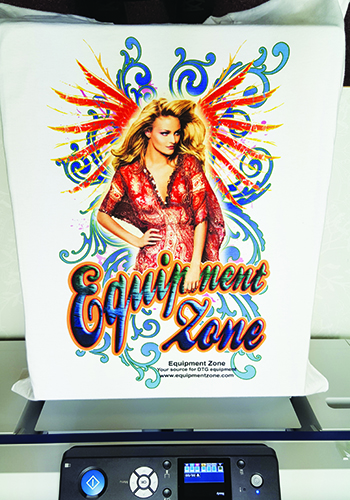Decorated-Apparel Transfer Printing with DTG
Today’s decorated-apparel professionals can dramatically expand their design and product offerings to include direct-to-film (DTF) with an existing direct-to-garment printer.
FULL STORY
When you think about the term “evolution,” you likely think about changes that occur during a long period of time. Not so with anything related to direct-to-garment (DTG) printing.
With respect to pretreatment solutions and methods, evolution and progress have occurred fast and furious, with the goal being to ready garments for this burgeoning decoration process as quickly as possible. For a decoration technique that is only about 10 years old, there have been many changes — and more are on the horizon.
Inkjet print heads dictate the type of water-based ink used, which in turn dictates the way printing is done on dark garments. In DTG printing, pretreating is required when using white ink, whether as a white image or an underbase. Using pretreatment on light garments when printing only CMYK is a matter of personal preference. Will the image be more crisp and wash better with pretreatment on a light garment? Yes, but a print without pretreatment also is acceptable.
There has been much experimentation during the past decade in the search for efficient ways to apply a consistent and even coat of pretreatment solution. Following is a look at where we’ve been, and techniques and methods we’ve left behind in that regard.
Hand-Held Pump Sprayer
This early attempt at pretreating garments for DTG printing worked to the extent that you could disperse the pretreat solution, but the uneven application could be seen in the final print. An irregular application will appear as bright and dull areas throughout the print. It’s extremely rare to see an operator using this method today.
Screen Printing The Pretreatment
Since many of the early innovators in this industry were longtime screen printers, it was only natural to attempt to screen print the pretreatment onto the shirt. The difficulty was in how thin pretreatment solution is and trying to apply it through a screen no matter how fine the mesh. Adding thickeners to the product resulted in a heavy application on the garment, causing a stiff feel. It was a reasonable idea that just didn’t pan out.
Power Paint Sprayer
The power paint sprayer evolved as a practical way to control laydown of pretreatment solution on the shirt and, to this day, is the most commonly used method. The drawback is the mess left behind due to overspray. It takes practice to get the stroke just right using this method.
Also, by atomizing the pretreatment solution and having it float in the air, this technique must be performed in a separate location from your DTG machine. It’s important to note that many operators tend to lay down too much pretreatment solution using this method.
Paint Roller
A fairly short-lived experiment to cut down on the paint sprayer atomized solution and mess was the use of a paint roller. The result was too much solution on the garment, wasted product trapped in the roller and the time-consuming aspect of applying, then drying the soaked-with-pretreatment garment. Hobbyists and some operators still choose this method, but it was, for the most part, another experiment that didn’t quite pan out.
Pretreat Papers
There has been experimentation and, in fact, implementation of pretreat papers — paper with a coating of wet pretreatment solution. While the concept is good and there is some potential for the future, the cost still is high and it is difficult to control the amount of solution applied. Different garment styles and brands will require the ability to more finely control the laydown amount.
Carding/Rolling The Fabric
Another early experiment was to pull a plastic card or paint roller across the fabric after applying pretreatment solution. The purpose was twofold. First, laying the fibers of the shirt down results in a better finished product. Second, the card or roller would even out an inconsistent laydown of pretreatment.
New methods of pretreatment have eliminated the need to even out the solution on the shirt. Understanding how to properly dry the shirt — using heavy pressure on the heat press — makes laying down the fibers before curing unnecessary.
Pretreatment Today
There are two recognized methods for professionally pretreating garments that will be printed via the DTG method. Most decorators entering the market now opt for automatic pretreating. This is the most consistent, repeatable and cleanest method available. An automatic pretreater will remove the variable of consistently even pretreatment from the decoration equation.
Under tight budget constraints, the power paint sprayer still is a viable option. Many longtime DTG decorators have developed skills in applying pretreat with a hand-held power sprayer and continue to employ this method. But these operators often make the investment into automatic pretreatment machines as a necessary element in their production packages.
Terry Combs is a 35-plus year veteran of the garment printing industry, and has managed production shops large and small across the United States. He currently does sales and training with Equipment Zone, Franklin Lakes, N.J. For information, visit terrycombs.com.
Today’s decorated-apparel professionals can dramatically expand their design and product offerings to include direct-to-film (DTF) with an existing direct-to-garment printer.
FULL STORYThe past few years have brought changes to almost every industry, and decorated garment production is no exception.
FULL STORYNew Jersey-based Breakthrough Custom Clothing created “Warrior Princess” from scratch by digitally hand drawing the entire piece.
FULL STORY